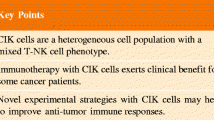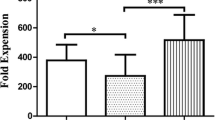Abstract
The possible use of spleen-derived mononuclear cells (SPMC) for the intentional and economical adoptive immunotherapy of cancer patients was studied. SPMC were obtained from spleens resected surgically from patients with gastric cancer or idiopathic thrombocytopenic purpura (ITP). When SPMC were cultured in recombinant interleukin 2 (rIL2), SPMC, in the form of interleukin-activated killer spleen cells (IL-SP) proliferated in six of eight cases. CD8+ lymphocytes were the major expanding cell population in most SPMC cultures and IL-SP showed a significant cytolytic activity against cultured tumor cells during cell proliferation. When cultured with a streptococcal preparation, OK-432, for 24 to 48 h, SPMC showed cytotoxic activity against tumor cells and were expressed as OK-432 activated killer spleen cells (OK-SP). The effects of supernatants from IL-SP and OK-SP on tumor cell growth were also examined. The supernatants from IL-SP and OK-SP significantly inhibited cell growth in 3 and 10 out of 11 cases, respectively, while those from OK-SP showed higher growth inhibitory activity than those from IL-SP. The results of this study indicate the potential of SPMC as effector cells for the adoptive immunotherapy of cancer patients.
Similar content being viewed by others
References
Grimm EE, Mazumder A, Zhang HZ, Rosemberg SA (1982) The lymphokine-activated killer cell phenomenon: Lysis of natural killer-resistant fresh solid tumor cells by interleukin 2-activated autologous human peripheral blood lymphocytes. J Exp Med 155:1823–1841
Lotze MT, Chang AE, Seipp CA, Simpson C, Vetto JT, Rosemberg SA (1986) High-dose recombinant interleukin 2 in the treatment of patients with disseminated cancer: Responses, treatment-related morbidity, and histologic findings. JAMA 256:3117–3124
Rosemberg SA, Lotze MT, Muul LM Chang AE, Avis FP, Leitman S, Linehan WM, Robertson CN, Lee RE, Rubin JT, Seipp CA, Simpson CG, White DE (1987) A progress report on the treatment of 157 patients with advanced cancer using lymphokine-activated killer cells and interleukin-2 or high-dose interleukin-2 alone. N Eng J Med 316:889–897
Rosemberg SA (1988) Immunotherapy of cancer using interleukin 2. Immunol Today 9:58–62
Uchida A, Mickshe M (1983) Lysis of fresh human tumor cells by autologous peripheral blood lymphocytes and pleural effusion lymphocytes activated by OK-432. J Natl Cancer Inst 71:673–680
Uchida A, Mickshe M (1983) Lysis of fresh human tumor cells by autologous large granular lymphocytes from peripheral blood and pleural effusions. Int J Cancer 32:37–44
De Ley M, Claeys H (1984) Streptococcal preparation OK-432-induced interferon in human leukocytes: Purification and characterization. Int Arch Allergy Appl Immunol 74:21–28
Ichimura O, Suzuki S, Saito M, Sugawara Y, Ishida N (1985) Augumentation of interleukin 1 and interleukin 2 production by OK-432. Int J Immunopharmacol 7:263–270
Katano M, Yamamoto H, Mizoguchi T, Hisatsugu T (1988) Induction of tumor growth inhibitory factor (TGIF) in human mononuclear cells by OK-432, a streptococcal preparation. Cancer Immunol Immunother 27:198–204
Yamamoto A, Nagamuta M, Usami H, Sugawara Y, Watanabe N, Niitsu Y, Urushizaki I (1986) Release of tumor necrosis factor (TNF) into mouse peritoneal fluid by OK-432, a streptococcal preparation. Immunopharmacology 111:79–86
Katano M, Mizoguchi T, Yamamoto H, Nakamura M, Matsuo T, Hisatsugu T, Kisu T, Yamaoka K, Tokunaga O (1990) The antitumor effects of locally injecting human peripheral blood mononuclear cells treated with OK-432 into the tumor site: The possible role of a tumor growth inhibitory factor (TGIF). Jpn J Surg 20:76–82
Toge T, Seto Y, Kuroi K, Yamada H, Aratani K, Fujita T, Yanagawa E, Hattori T (1987) Relationship of the distribution of Leu-2+ cells with suppressor cell activities in the spleen and lymph nodes from gastric cancer. Jpn J Surg 17:72–77
Yanagawa E, Toge T, Sawamura A, Kegoya Y, Baba N, Hattori T (1988) The regulation of natural killer cell activity by splenic nonspecific suppressor cells and its modification in cancer patients. Jpn J Surg 18:660–667
Akiyoshi T, Koba F, Miyazaki S, Arinaga S, Tsuji H (1983) NK activity, TCGF production, and generation of cell-mediated cytotoxicity in spleen cells from gastric cancer patients (in Japanese with English Abstract). Nippon Geka Gakkai Zasshi 84:967–970
Miller SC (1982) Production and renewal of murine natural killer cells in the spleen and bone marrow. J Immunol 129:2282–2286
Fisher RI, Coltman CA, Doroshow JH, Rayner AA, Hawkins MJ, Mier JW, Wiernik P, Mcmannis JD, Weiss GR, Margolin KA, Gemlo BT, Hoth DF, Parkinson DR, Paietta E (1988) Metastatic renal cancer treated with interleukin-2 and lymphokine-activated killer cells: A phase II trial. Ann Intern Med 108:518–523
Kradin RL, Kurnick JT, Lazarus DS, Preffer FI, Dubinett SM, Pinto CE, Gifford J, Davidson E, Grove B, Callahan RJ (1989) Tumor-infiltrating lymphocytes and interleukin-2 in the treatment of advanced cancer. Lancet 18:577–580
Rosemberg SA, Packard BS, Aebersold PM, Solomon D, Toy ST, Simon P, Seipp CA, Simpson C, Charles C, Bock S, Schwartzentruber D, Wei JP, White DE (1988) Use of tumor-infiltrating lymphocytes and interleukin-2 in the immunotherapy of patients with metastatic melanoma: A preliminary report. New Eng J Med 319:1676–1680
Rosemberg SA, Spiess P, Lafreiere RL (1986) A new approach to the adoptive immunotherapy of cancer with tumor-infiltrating lymphocytes. Science (Washington) 233:1318–1321
Damle NK, Doyle LV, Bradley EC (1986) Interleukin-2-activated human killer cells are derived from phenotypically heterogeneous precursors. J Immunol 137:2814–2822
Itoh K, Tilden AB, Kumagai K, Balch CM (1985) Leu-11+ lymphocytes with natural killer (NK) activity are precursors of recombinant interleukin-2 (rIL2)-induced activated killer (AK) cells. J Immunol 134:802–807
Heo DS, Whiteside TL, Johnson JT, Chen K, Barnes EL, Herberman RB (1987) Long-term interleukin-2-dependent growth and cytotoxic activity of tumor-infiltrating lymphocytes from human squamous cell carcinomas of the head and neck. Cancer Res 47:6353–6362
Katano M, Yamamoto H, Mizoguchi T, Iyama A, Matsuo T, Nakamura M, Hisatsugu T, Torisu M (1989) Induction of a tumor growth inhibitory factor (TGIF) in human mononuclear cells by OK-432. Possible clinical use of TGIF. In: Torisu M, Yoshida T (eds) International symposium on new horizons in tumor immunotherapy. Elsevier, Amsterdam, pp 405–416
Katano M, Yamamoto H, Matsuo T, Nakamura M, Mizoguchi T, Hisatsugu T (1989) Clinical significance of tumor growth inhibitory factor (TGIF). In: Proceedings of the 7th International Congress of Immunology, Berlin (abstract)
Katano M, Yamamoto H, Nakamura M, Matsuo T, Hisatsugu T (1990) Synergistic effects of TGIF and interferon γ (IFN γ) on tumor growth. Biotherapy 2:33–40
Author information
Authors and Affiliations
Rights and permissions
About this article
Cite this article
Katano, M., Yamamoto, H., Kubota, E. et al. The possible use of spleen cells for the adoptive immunotherapy of cancer patients. Surg Today 23, 13–20 (1993). https://doi.org/10.1007/BF00308994
Received:
Accepted:
Issue Date:
DOI: https://doi.org/10.1007/BF00308994




